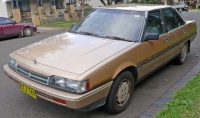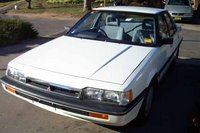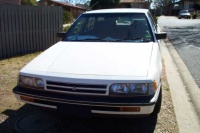Difference between revisions of "First Generation Magna"
| Line 1: | Line 1: | ||
| − | + | The '''First Generation Magna''' was introduced to the Australian market in 1985 and was described as being revolutionary and in a class of its own. The Magna created what would be marketed years later as the "wide-bodied" car. The Magna was based upon the Japanese [[5g_galant|Galant]] which [[MMAL|Mitsubishi Motors Australia Limited]] (MMAL) deemed to be too narrow. As with all Japanese cars of the time, the Galant was required to be less than 1.7 metres in width or else buyers would have to pay a limosine tax. | |
| − | |||
| − | |||
| − | |||
| − | The '''First Generation Magna''' was introduced to the Australian market in | ||
MMAL decided that the interior size of the Galant and 2.0 litre engine were too small for the Australian market. This meant the car had to be re-engineered to meet MMAL's requirements effectively creating a very different car. MMAL was very interested in using the [[Astron]] engine, which was very popular in the [[Sigma]]. By 1982, the majority of Sigmas sold were fitted with the optional 2.6 litre version of the engine. The 2.6 litre engine was popular in the Sigma mainly because of it's large amount of torque and comparable fuel economy. | MMAL decided that the interior size of the Galant and 2.0 litre engine were too small for the Australian market. This meant the car had to be re-engineered to meet MMAL's requirements effectively creating a very different car. MMAL was very interested in using the [[Astron]] engine, which was very popular in the [[Sigma]]. By 1982, the majority of Sigmas sold were fitted with the optional 2.6 litre version of the engine. The 2.6 litre engine was popular in the Sigma mainly because of it's large amount of torque and comparable fuel economy. | ||
Revision as of 13:05, 31 August 2015
The First Generation Magna was introduced to the Australian market in 1985 and was described as being revolutionary and in a class of its own. The Magna created what would be marketed years later as the "wide-bodied" car. The Magna was based upon the Japanese Galant which Mitsubishi Motors Australia Limited (MMAL) deemed to be too narrow. As with all Japanese cars of the time, the Galant was required to be less than 1.7 metres in width or else buyers would have to pay a limosine tax.
MMAL decided that the interior size of the Galant and 2.0 litre engine were too small for the Australian market. This meant the car had to be re-engineered to meet MMAL's requirements effectively creating a very different car. MMAL was very interested in using the Astron engine, which was very popular in the Sigma. By 1982, the majority of Sigmas sold were fitted with the optional 2.6 litre version of the engine. The 2.6 litre engine was popular in the Sigma mainly because of it's large amount of torque and comparable fuel economy.
In 1982 the YF-W project began. The project was to create a new car (based on the Galant's body) which had an acceptable amount of interior space and could house the 2.6 litre engine. In the end, the car was widened by 65mm.
Whist the body was being developed, the engine was also being modified. The result was an engine that felt much different to is predecessor. Power increased from 76kW @ 4800 rpm to 83 kW @ 5200 rpm and torque increased from 192 Nm @ 2400rpm to 200 Nm. This engine became known as the Astron II.
In 1985 when the Magna was released, it was available in three variants - GLX, SE and Elite. Each was more luxurious than the first. The SE and Elite also had "wing controls" - whereas all the major controls for the vehicle were near the steering wheel within a small reach from the driver.
Upon release, the Magna became a real competitor for the Holden Commodore and Ford Falcon. The Magna had more interior space than the Commodore and had better performance than the other two in base form. Both Commodore SL and Falcon GL had out-dated OHV 3.3 litre 6 cylinder engines as standard producing 86 kW and 90 kW respectively. Both cars were heavier and consumed more fuel.
The Magna was also a step up from the Commodore and Falcon in terms of features - it featured 4 wheel disc brakes, 4 speed automatic or 5 speed manual on all models. Commodore and Falcon had optional 4 wheel discs and 5 speed manuals, but there was no 4 speed automatic available.
TM
| TM | ||||||||||||||
|
The TM was the first Magna built. The sole engine was the 2.6L carburetted Astron II mated to a 5 speed manual or 4 speed automatic transaxle.
At the end of 1985, Mitsubishi fitted catalytic converters to their vehicles readying them for sale in 1986 as the government had mandated operation of all new vehicles on unleaded fuel.
In August of 1986, MMAL introduced the Magna Executive, aimed at fleet buyers. It was a GLX with manual or automatic transmission and power steering. The only option was air conditioning, making it an easy choice for fleet buyers. The A and B pillars were painted black like on TN and TP Executives.
TN
| TN | ||||||||||||||
|
The TN model was the second Magna model. Cosmetically it had a revised rear end (with the number plate moved to the back bumper bar and a red facia between the tail lights) and had 2 distinct grilles. The GLX, Executive and Elante all had a mailbox grille (Elante's grille was painted the same colour as the car) while the SE and Elite had a fancy bar grille. The sides of the car were also fitted with better looking, fatter bump strips. Manual and Auto were avaliable in GLX, SE and Elante models and are more common than Auto. While Executive and Elite were Auto only. About 60% TN models come in Executive form.
The interior was left largely the same with only the trim being updated. Interior colours would vary to match the exterior colour. Interior colours were available in Blue, Grey and Brown.
The TN introduced some of the biggest changes in the entire generation. EFI became an option, the Magna wagon was introduced and in May 1988 the Elante (a sporty variant) was released. Transaxles were also changed, with EFI automatics receiving the much improved KM177 (Carby models stayed with the KM175). Manual models received a new KM210 5 speed manual.
TP
| TP | ||||||||||||||
|
The TP was the final model of the first generation. Externally, it can be distinguished from other models by it's metal framed grille (with platic slat inserts) at the front and having black decals with silver lines in the center of the tail lights and rear facia. The GLX, Executive, SE and Elante models were avaliable with manual or automatic transmission, while the Elite was automatic only. Even though the Elante was available with an automatic, automatic Elantes are particularily rare. The Grand Tourer, a limited edition model was available in manual and auto.
Inside the TP was similar to previous models, with updated trim (seat coverings and new headrests) and a new centre console. Instead of the top of the console being just below the dashboard as in the TM and TN, the TP ran right up and locked flush with the dashboard. The ashtray was relocated to the console and a cup holder was also added. The new console also made the stereo much harder to steal as it was far more secure.
The mechanical biggest change occured in the automatic models. A revised edition of the KM177 4 speed automatic introduced in the TN EFI model known as the KM177-6 was introduced. This new transaxle was available on both carby and EFI models. It was much stronger than the old KM175 (fitted to all carby models) and included a power and economy mode. Its possible to fit the KM177-6 to TM and TN models, many have been fitted as replacement gearboxes.
Electronic Fuel Injection (EFI) and security coded stereos was made standard on all SE and higher models. Was also avaliable on GLX and Executive models. Manual was also avaliable on the Executive EFI model, but far more common on GLX models.
The TP also marked the introduction of the Electronic Time Alarm Control System ETACS in the Elite model.
In 1990, a special edition Grand Tourer was released to celebrate Mitsubishi's 10th year of manufacturing in Australia. This special model included Elante suspension, a front spoiler, boot lid spoiler, improved front seats and an TN Elante steering wheel with black and gold insert.


